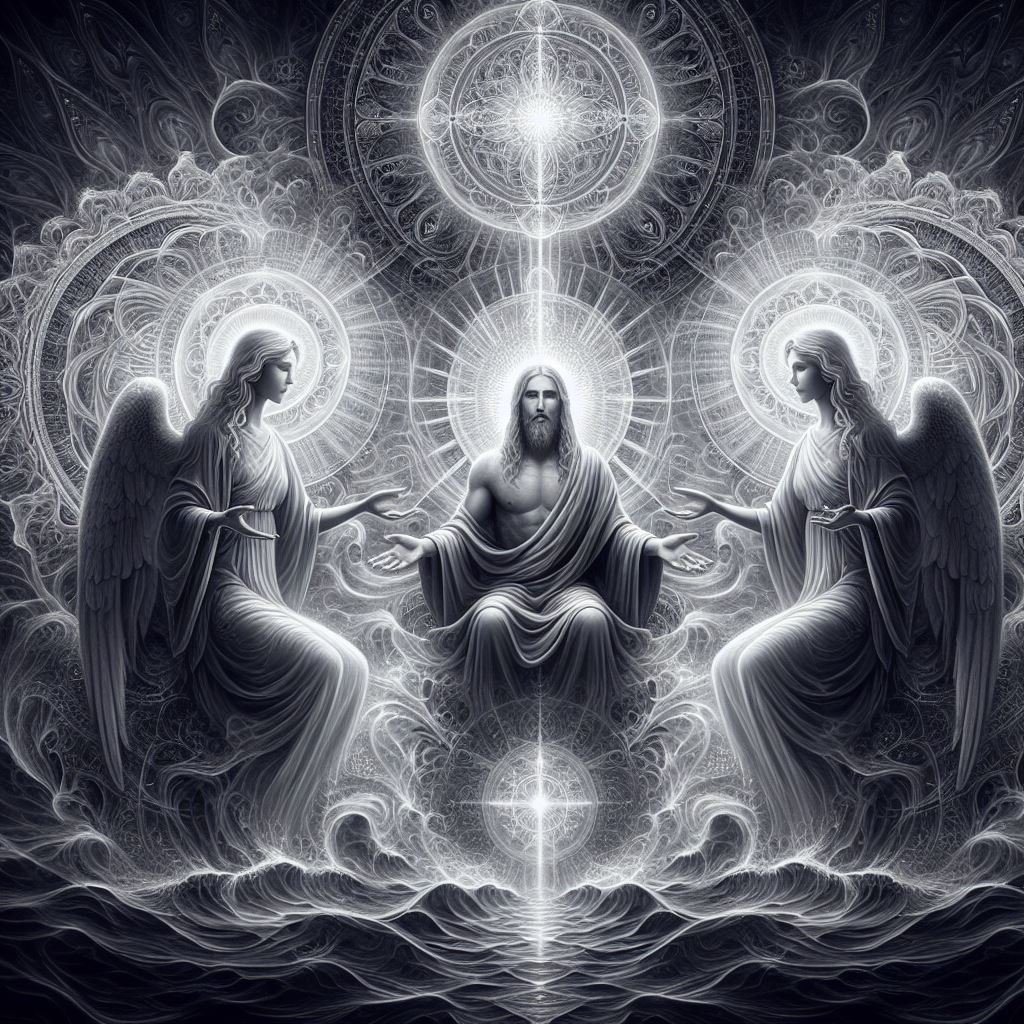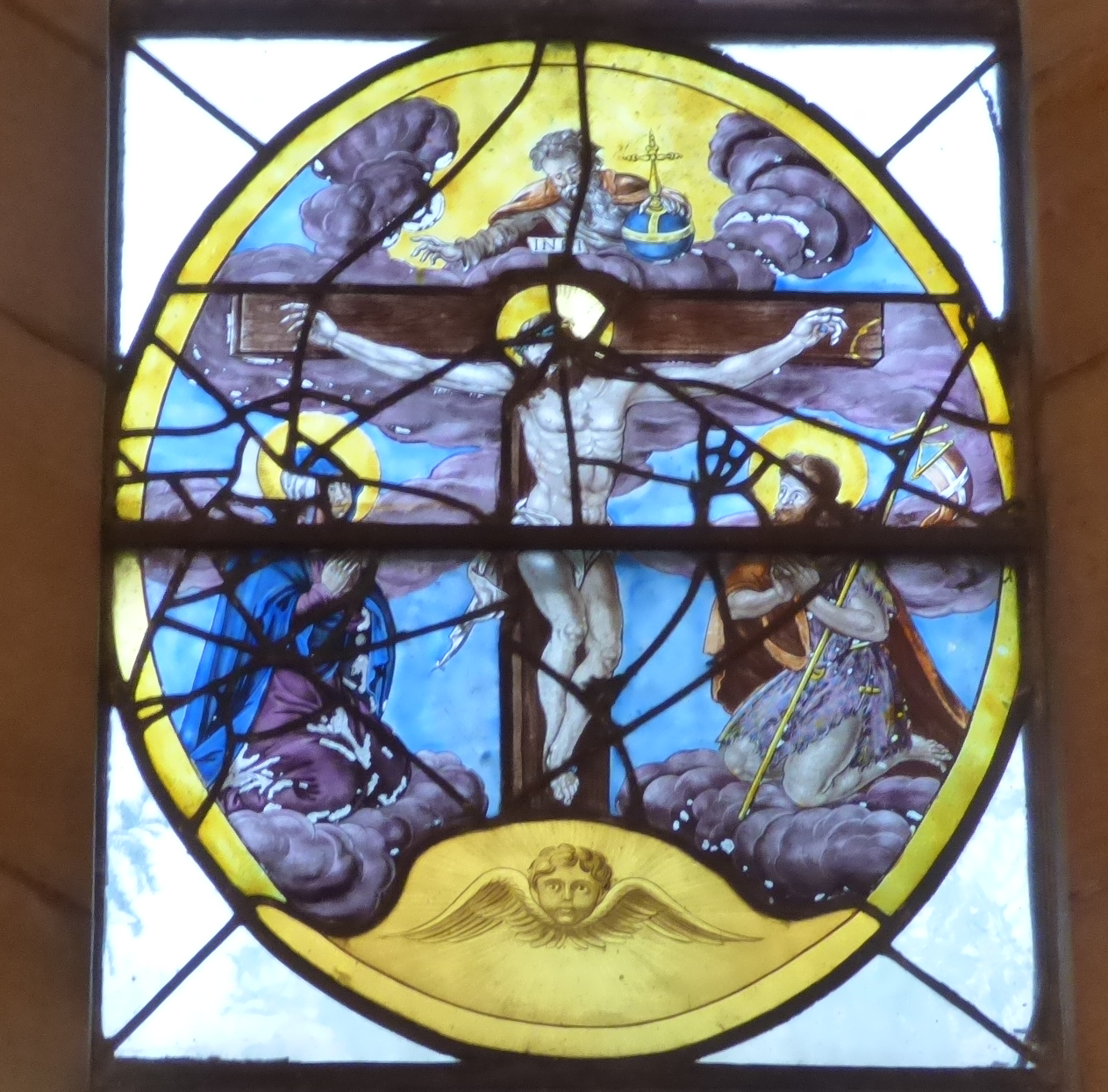
I travelled to a church in England, where the vicar told me that the window I was looking at, contained a graven image of God the Father. That graven image was of a trinity, it showed God the Father, speaking to the divine masculine and the divine feminine, through Christ consciousness

These windows also appeared to show that Mary Magdalene had equal status to Jesus, in so much as she is depicted as the embodiment of the divine feminine and he of the divine masculine. Whilst this interpretation is initial (that the woman depicted alongside the Christ was Mary Magdalene), It is notable that this is one of the few remaining churches with its original medieval windows.

And I’m reminded that the Victorians replaced the vast majority of church windows in Britain. Are those original windows preserved in any way? If not, doesn’t that raise questions about how our religious views have changed, and to what end?
The preservation of medieval church windows in England is a subject of both historical significance and cultural heritage. The intricate designs and the stories they tell form an essential part of the architectural narrative of these ancient structures.
However, the Victorian era saw extensive refurbishment and rebuilding of Church of England churches, a period known as the Victorian restoration. This movement was not synonymous with the modern understanding of building restoration but was rather a time of significant change, which included the replacement of many medieval windows with new designs. The reasons for this ranged from the practical—such as the deterioration of the original windows—to the ideological, as the Victorians had their own interpretations of ecclesiastical art and architecture. What is interesting, however, is that the Victorians chose not to record any of the windows that were replaced, and very few people today would think that our beliefs could be significantly different to those we had for at least the 400 years before the Victorian period. Yet, comparing the beliefs shown in these windows, it is clear that the divine feminine seems to have become hidden, making our true understanding of God, more obscure, which means less of us, are actually worshipping the wholeness of the divine one.
The concept of divinity encompassing both male and female aspects is a profound one, reflecting a balance and wholeness within the divine nature. If such a balanced representation were more widely recognized, it could potentially offer a more inclusive and equitable perspective on spirituality and divinity. This could encourage a deeper understanding and respect for the feminine divine, which has historically been less emphasized in many traditions.
Recognizing the equal importance of both masculine and feminine aspects of the divine might lead to a more harmonious society, where the values associated with both are celebrated and integrated. It could challenge outdated notions of superiority and promote a world-view that values equality and unity. Such a shift in perception could have far-reaching implications, not only for individual spiritual journeys but also for societal norms and gender relations.
It might inspire a reevaluation of roles and power structures, leading to more balanced and fair opportunities for all genders. In essence, embracing a more holistic view of the divine could be a step toward a more just and compassionate world. However, it’s important to note that these are speculative thoughts and the actual impact would depend on a multitude of factors, including cultural, religious, and individual interpretations and actions.
Yet, we see here, that in England, what was once a common belief, has been obscured.
Regarding the interpretation of religious imagery, the Christian doctrine of the Trinity, which encompasses the unity of Father, Son, and Holy Spirit as three persons in one Godhead, is a central affirmation of the faith. However, interpretations and representations of the Trinity have varied over time and across different Christian denominations. The depiction of Mary Magdalene as having equal status to Jesus in the divine narrative is less common in traditional Christian iconography, which typically emphasizes the roles of the Virgin Mary and the saints.
Mary Magdalene’s historical portrayal has evolved significantly over the centuries, reflecting the changing attitudes of society and the church towards women and their roles in religious narratives. In the canonical Gospels of the New Testament, Mary Magdalene is presented as a devoted follower of Jesus, present at his crucifixion and the first to witness his resurrection. However, her character and story have been subject to various interpretations and embellishments beyond the biblical texts.
The Western Christian Church, for many years, depicted Mary Magdalene as a repentant sinner, a narrative that began with Pope Gregory I’s homily in 591, where he conflated her with the unnamed sinner in Luke’s Gospel and Mary of Bethany. This portrayal was not universally accepted, as the Eastern Orthodox Church continued to honour her as a devoted disciple without the penitent sinner narrative.
Renaissance art and literature often depicted Mary Magdalene in a manner that emphasized her supposed penitence, sometimes portraying her as a voluptuous figure, which further cemented her image as a sinner in the public consciousness. This misrepresentation persisted until modern scholarship began to challenge these notions, particularly with the discovery of the Gnostic Gospels, which include the Gospel of Mary. These texts offer a different view of Mary Magdalene, describing her as a spiritual leader and a favoured disciple of Jesus.
Yet, our churches continue to peddle this myth of inequality. It’s worth asking ourselves, why would a church accidentally, ineptly, misinterpret such a key understanding, into a confusion that allows it to essentially, lose its way?
The revisionist history of Mary Magdalene gained momentum with the work of scholars like Jaques Laefevre d’Etaples in the 16th century, who argued against the conflation of Mary Magdalene with other female figures from the Bible. This shift in perspective opened the door for a re-evaluation of her role and significance in the early Christian movement.
However, nothing of substance was actually done, in response to this, and as we can see, in England, the removal of Mary Magdalene continued long after this conflation was denounced.
In recent years, the figure of Mary Magdalene has been the subject of renewed interest and study. Scholars have sought to separate fact from fiction, examining both textual and archaeological evidence to gain a clearer understanding of her life and influence. Despite the lack of concrete evidence regarding many details of her life, it is clear that Mary Magdalene holds a significant place in Christian history as a symbol of devotion and as a witness to the central events of the Christian narrative.
The ongoing exploration of Mary Magdalene’s portrayal highlights the broader discussion about the representation of women in religious texts and the importance of re-examining historical narratives to uncover a more balanced and accurate understanding of the past. It also highlights, however a confusion about God, that indicates, either, they have no connection to the divinity they claim to speak for, or, that this is deliberate, that the church has deliberately changed our understanding of God, and that, I suggest, this is why so many us can’t contact God, our church makes us insist this God of ours appears as they tell us, not as it will present itself to us. And therefore, we will tend to reject it, for fear of evil spirits!
In contemporary Christian thought, there is a growing discussion of the balance between the divine masculine and divine feminine. However, it is clear that much of this has been forced on the church due to anti-discriminatory laws, anyone who has followed this debate knows that without those laws, and other pressures, there would would be little to cause the church to debate how “Godly”, our women are.
Some theologians and spiritual writers, however, have explored this concept. For instance, the idea of the divine feminine is sometimes associated with the Holy Spirit or Wisdom, which in Hebrew is a feminine word, ‘Sophia’. This aspect of divinity is seen as nurturing, gentle, and compassionate, qualities traditionally associated with femininity. Additionally, some modern interpretations of the Trinity incorporate a feminine element, viewing the Holy Spirit as the maternal aspect of God, complementing the paternal aspect of the Father and the fraternal aspect of the Son.
The role of Mary Magdalene has also been re-examined in recent years, with some scholars suggesting that she represents the divine feminine and was a leader in the early Christian community. This perspective is supported by certain non-canonical texts and the prominence given to her in the Gospels as the first witness to the resurrection. The concept of Christ consciousness, is another area where the divine masculine and feminine are considered to be in dialogue. It is a term used in some spiritual circles to denote a higher state of awareness and unity with the divine, transcending traditional gender roles.
Moreover, there are Christian communities and theologians who advocate for a more inclusive understanding of the divine that embraces both masculine and feminine qualities. They argue that God, being beyond human comprehension, encompasses all aspects of gender. This inclusive view is reflected in certain liturgical practices, prayers, and hymns that address God with both masculine and feminine language.
But these views are diverse and not all are accepted by mainstream Christianity. Traditional doctrine maintains the gendered language of Father and Son within the Trinity, with the Holy Spirit often understood as gender-neutral or masculine. However, the exploration of the divine feminine and the re-evaluation of figures like Mary Magdalene reflect a broader movement within Christianity towards a more expansive understanding of the divine that includes both masculine and feminine dimensions. This movement seeks to recover aspects of Christian tradition that have been overlooked and to offer a richer, more inclusive spirituality.


Truth of Self › Forums › Was Christianity in England changed during the Victorian period?
Tagged: Christ, Chritainity, divine masculine, female, God, graven image divine feminine, Jesus, male, Manipulation, Religious, suppression